One of the best things to happen to me during my career was something that I initially rejected, and felt was a major step backwards.
 In 2002, I was hosting afternoons and programming 1340/1390 ESPN Radio in Poughkeepsie, NY. I spent a few years prior working for a smaller local station (WTBQ), so this was my first entry into working for a corporate group, and having an opportunity to test myself on a bigger station with a bigger audience against larger expectations.
In 2002, I was hosting afternoons and programming 1340/1390 ESPN Radio in Poughkeepsie, NY. I spent a few years prior working for a smaller local station (WTBQ), so this was my first entry into working for a corporate group, and having an opportunity to test myself on a bigger station with a bigger audience against larger expectations.
Everything was going great, and I felt I was making inroads in my career, when all of a sudden, the bottom fell out.
I was called into the upstairs office, and informed by my GM (Chuck Benfer) that our new owners had made a decision to flip my sports station to Spanish. Chuck and I had a great relationship and he wanted to keep me around, so he asked if I would consider moving over to the rock station 101.5 WPDH, where I’d serve as Producer of the Morning Show “Wakin Up with Coop and Mikey“. I’d also host a weekly wrestling show on Sunday evenings, which allowed me to maintain my on-air chops.
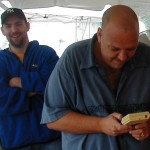 In that moment, I had to choose between staying in the business, and doing something outside of my comfort zone, or declining the opportunity, and pursuing other jobs in sports radio while being unemployed. Having a family to feed, I chose the paycheck, and to this day, I am extremely glad I did.
In that moment, I had to choose between staying in the business, and doing something outside of my comfort zone, or declining the opportunity, and pursuing other jobs in sports radio while being unemployed. Having a family to feed, I chose the paycheck, and to this day, I am extremely glad I did.
At the time, this was foreign territory for me, and while I loved Howard Stern, I wasn’t a big fan of morning shows on music stations. A lot of the entertainment felt forced and hokey to me, and I worried that I’d be involved in a similar situation. Waking up at 3am also didn’t have a lot of appeal, but getting a 2 second cameo on the first season of “American Chopper” made up for it (sort of).
I often reflect on the 2 years I spent working outside of sports radio as a huge positive, because it taught me a lot about being able to entertain an audience in a short period of time. It also pushed me creatively to think about things differently, and take chances with content that I might not have otherwise considered.
When you’re hosting a sports talk show, you do a lot of reading, and you beat to death the two or three local stories with a few opinions, phone calls, and interviews. Rarely do you look at each minute of your show as being critically important. The mindset usually is “we have 3-4 hours to cover, so there’s plenty of time to do things, and the audience will accept it”.
When you work on a morning show that plays music, and allows for short talk segments, your content selection and execution has to be crisp, and if you miss on an opportunity, it could be another 30-45 minutes before you get a chance to redeem yourself. That is a personal hell for any on-air entertainer.
 My time with WPDH lasted a little over a year, and I moved from there to another rock radio station (PYX 106 in Albany, NY) where I spent 6 months producing the “Wakin Up With The Wolf” show with Bob Wohlfeld, Ellen Z, Ethan Youker and my personal favorite, John Tobin.
My time with WPDH lasted a little over a year, and I moved from there to another rock radio station (PYX 106 in Albany, NY) where I spent 6 months producing the “Wakin Up With The Wolf” show with Bob Wohlfeld, Ellen Z, Ethan Youker and my personal favorite, John Tobin.
John built a strong brand at WPDH prior to moving to PYX 106, and although we knew each other, and shared mutual friends, we had never directly worked together. He delivered big ratings on the shows he was part of, and I was a big fan of his work, so I knew it’d be fun collaborating, and learning from him.
I quickly learned that despite being a phenomenal morning talent, John hated waking up and doing mornings. However, once the light went on, he was ready to perform. His natural talents and energy took over, and his ability to be spontaneous, and keep his partners on the edge of their seats, fueled the show to have incredible success.
 That talent led to him having multiple successes in Albany. He made a huge impact on the morning show on PYX 106 , and then switched gears and hosted an afternoon sports talk show on the Fox Sports Radio affiliate with Freddie Coleman. Freddie as you know has since gone on to a very successful career at ESPN Radio.
That talent led to him having multiple successes in Albany. He made a huge impact on the morning show on PYX 106 , and then switched gears and hosted an afternoon sports talk show on the Fox Sports Radio affiliate with Freddie Coleman. Freddie as you know has since gone on to a very successful career at ESPN Radio.
What I learned during the time I worked with John was that there is a method to the madness when it comes to creating bits, characters, impersonations, and parodies. John is creatively brilliant, and enjoys performing, but he’s also a harsh critic. He’s not afraid to throw an idea away, even if it might be suitable to the rest of the room. If it’s not great, doesn’t leave the audience craving more, and doesn’t leave the cast on the show in stitches, he’ll revisit the idea later, or throw it out and work on something else.
As someone who listens to, and appreciates great comedy in radio, I believe bits, characters, impersonations, stunts and parodies can greatly enhance and compliment a show. Look around the country today and you’ll find a number of people doing this well. Lance Zierlein in Houston, Joe Conklin on WIP, Mike Bell in Atlanta, Whitey Gleason in Sacramento, Jay Mohr at Fox Sports, and Gregg Giannotti at the CBS Sports Radio Network all come to mind. Another guy who’s still developing but also has a knack for this is Clayton Miller.
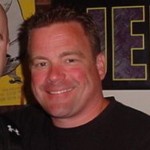 Turn on your television and you’ll also find shows like Family Guy, The Simpsons, South Park, and the Impractical Jokers who employ this same approach, and make a LOT of money, and generate large audiences. I watched the same strategy work firsthand for one of my best friends’ brothers, Johnny Brennan, who created the Jerky Boys, and built his brand into a mainstream success.
Turn on your television and you’ll also find shows like Family Guy, The Simpsons, South Park, and the Impractical Jokers who employ this same approach, and make a LOT of money, and generate large audiences. I watched the same strategy work firsthand for one of my best friends’ brothers, Johnny Brennan, who created the Jerky Boys, and built his brand into a mainstream success.
Bear in mind, all of these elements have to be executed well in order to be effective, and the talent has to have great ability to pull them off. When done right, they create a surprise in the programming, and keep an audience craving more, and sharing their listening experience with anyone around them who will listen. When done poorly, it can add a speed bump the size of a mountain into your show.
I thought it’d be fascinating to get inside the brain of someone who does this well, and knows what to look for and avoid when introducing new elements into a show. John was gracious enough to take some time and share his own personal account for what goes into the creative process, and if you’re curious to learn what works, what doesn’t, and the challenge with executing each strategy, I think you’ll enjoy this.
On an unrelated note, if you work on a show and John is ever coming through your city doing stand-up, or you’re just looking for someone to add some entertainment value to your show, get in touch with him. He’s very entertaining and skilled in creating memorable radio moments.
Here’s a quick sample from one of his standup performances. Be advised, there’s some colorful language in it.
Creating Bits, Characters and Impersonations by John Tobin
When it comes to radio bits, here are some simple do’s and don’ts.
DO: Be Funny!
DON’T: Be Unfunny!
Sounds obvious, right? However, executing this requires a sense of what the audience will react to with laughter. A sharp sense. I recognize that this is the equivalent of telling a would-be musician, “be musical“, but that’s the reality of it.
Let’s talk about a few different types of bits.
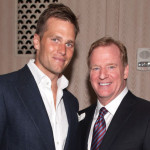 FLY on the WALL: “Gee, I wonder how the conversation went when Goodell sat down with Brady and his reps.”
FLY on the WALL: “Gee, I wonder how the conversation went when Goodell sat down with Brady and his reps.”
This will take some imagination and probably 2-3 voices. Basically, it’s sketch comedy. Let it build. These are fun to create and will allow you to depart from the typical, “Host A and Host B discuss an issue.” Work it out. Record it. Roll it out on the air.
Song Parodies and Produced Pieces:
A song parody is a great vehicle for humor. If you don’t believe me, look at the size of Weird Al’s pool. Try to jam your parody with jokes. Write the jokes first. Keep them on the side. Then make them rhyme. Try them out on people. The stronger ones go deeper into the tune.
The punchline of a parody is typically a pun on the title of the original song. If the pun is the only laugh, keep the parody short. Give the context with the verse, drop the punchline on them and scram.
EMPHASIS: If there’s only one joke don’t try to extend the bit.
There’s nothing worse than a parody with a throwaway (non-humorous) verse that goes beyond the punchline. All you’re doing at that point is offering another throwaway verse and making the audience wait for the same punchline, which is no longer a punchline since they’ve already heard it.
If you’re loading it up with funny lines, by all means go 2 verses (and if it’s hilarious, go for three, as long as the third verse has some kind of twist). Recognize when you have a one-joke bit, and resist beating a dead horse.
 I used to argue with a partner about a particular bit by a band that called itself, “Hayseed Dixie“, who covered AC/DC songs in bluegrass style. “She was a fast machine / she kept her motor clean“, check please. I get it, “You Shook Me (all night long)” over banjos and washboards.
I used to argue with a partner about a particular bit by a band that called itself, “Hayseed Dixie“, who covered AC/DC songs in bluegrass style. “She was a fast machine / she kept her motor clean“, check please. I get it, “You Shook Me (all night long)” over banjos and washboards.
I get it. No, really, I get it. TURN IT OFF.
It’s funny…. for about 15 seconds….then it gets tedious because the joke is over. We used to argue every time because he insisted on playing the full 2 minutes. But the joke is OVER! This is where your sense of “audience” has to come to the rescue.
As far as a tempo, bear in mind that you want them to hear every syllable, so, not too fast. Too slow is bad too, because you don’t want the audience to have SO much time that they can figure out where you’re going. Pace is important.
John Tobin’s “Sofa King” Commercial
LIVE Character Bits:
These have always been a favorite of mine. If you can break into (and think as) a character it adds such a dimension to the show. If you do it spontaneously, even better. Surprise everyone in the room. Of course, you need to have that sort of leeway, but if you do, it’s always a turning point in the mood and feel of the show. Such a great pivot.
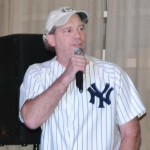 If spontaneity isn’t something you can get away with in your particular situation, you can open a break by having the character introduced, “Joining us in the studio“.
If spontaneity isn’t something you can get away with in your particular situation, you can open a break by having the character introduced, “Joining us in the studio“.
One way we’d shoehorn a character into the program was via a corny “knock on the door” which was literally knuckles on the console. “Oh, hey, look who’s here!”, and off you go.
I always found that characters who had an attitude worked best. Don’t be afraid to be a little aggressive and OWN the room. One character bit you can go to pretty easily is “the fan of your rival“. Think Red Sox fan. Think Yankee fan. Think Auburn/Alabama.
Use the accents, use the attitude, create a caricature. It’s a great device, and easy to score with since the resonance is built-in.
John Tobin’s character “Esteban” delivers bad pickup lines
Phone-ins and Impersonations:
These are also fun and can be very short & sweet. One great use of an in-studio phone is the “second-life“. If, in the middle of a busy break, you think of something funny to say but you can’t fit it into the show in that moment, do not despair. Sure, the moment may have passed for you to use the line as YOU, but if there’s a phone in the studio, you’re golden.
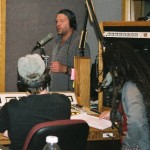 I’ll grab the console phone and lean out of sight. My partner will see me wiggle four fingers (meaning Line 4, our Hotline) and give the call letters as he picks up. I’ll then do a 2-second re-set, “A minute ago you were saying“___<reset>___” and I was thinking, “____<joke>_____”.
I’ll grab the console phone and lean out of sight. My partner will see me wiggle four fingers (meaning Line 4, our Hotline) and give the call letters as he picks up. I’ll then do a 2-second re-set, “A minute ago you were saying“___<reset>___” and I was thinking, “____<joke>_____”.
The phone-in can also be used in the exact same way as the LIVE character.
I started in radio as a freelance contributor to a morning show (i95 in CT). I used to write scripts at home and fax (yes, fax…Pony Express had shut down by then) the in-studio guys their parts. Their scripts would have only a slight hint of my line, because I didn’t want to tip the punchline. They’d take my call LIVE and we’d roll with it. For this, I received the grand sum of $12.50.
Impersonations:
As far as impressions go, it’s something you’re either born with, or not. Just like musicality. However, sometimes you can fake it.
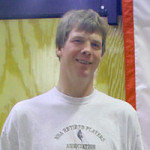 The Rik Smits voice, for example, is completely something I ascribed to him. I have no idea how Rik sounds so I just created a character and made him into Arnold Schwarzenegger as a nasty pro wrestler. I was so committed to its delivery and its attitude that I established it as his voice. From what I understand, Rik is actually fairly soft spoken.
The Rik Smits voice, for example, is completely something I ascribed to him. I have no idea how Rik sounds so I just created a character and made him into Arnold Schwarzenegger as a nasty pro wrestler. I was so committed to its delivery and its attitude that I established it as his voice. From what I understand, Rik is actually fairly soft spoken.
That’s one way out of doing an inaccurate impression. You decide what the impression is going to be and commit to it 500%. To make it work, try to find the salient characteristics of it and caricature them. That’s another way to bail out of not being able to nail an impression 100%.
John Tobin’s “I Am Enormous” as sung by the Rik Smits character
 For Chris “Mad Dog” Russo, the impression I performed was significant because he was local and he was popular. He also has a loud, over the top persona which was easy to parody. What you try to look for are things that other people might overlook.
For Chris “Mad Dog” Russo, the impression I performed was significant because he was local and he was popular. He also has a loud, over the top persona which was easy to parody. What you try to look for are things that other people might overlook.
For instance, “Mad Dog” does this “gasping-for-air inhale” after he laughs. I always exaggerated it and dragged it out to about two and a half seconds.
He also has a problem pronouncing the R and L. I did a bit once where he discussed nothing but the Royals, Orioles, and Oilers. All of which he pronounced identically ERLLOLRRLLERL.
WHO?
The ERLLOLRRLLERL.
WHO?
Kansas City!
I would get the character speaking so fast that everything became unintelligible except for every 19th word. Gibberish–gibberish-gibberish Yankee Stadium. Gibberish-gibberish-gibberish $10 beer. Of course, you want to latch onto a couple of catchphrases that the individual uses. In Chris’ case, “give me a break, for Pete’s sake and for crying out loud”, were all part of his repertoire.
John Tobin’s “Chris “Mad Dog” Russo” Impersonation
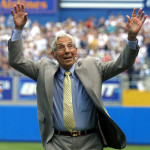 One bit I created and wrote was Phil Rizzuto’s Mini-Golf. The Scooter would call-in to announce his Grand Opening and every hole had a theme. Each theme centered around its own current sports story.
One bit I created and wrote was Phil Rizzuto’s Mini-Golf. The Scooter would call-in to announce his Grand Opening and every hole had a theme. Each theme centered around its own current sports story.
There was a Lawrence Taylor-themed hole. A Pete Rose-themed hole. Today, you could go with a Patriots/Brady-themed hole or maybe one for Rex Ryan. One theme/one joke. However many solid jokes you can come up with, that’s how many you talk about. Then, you’re done.
Another character I used to do was Dunkin Downe, a 6’9 goggle-wearing power forward with a sense of humor. One time Dunkin called in and did an entire bit on the size of the Piston’s Vinnie Johnson’s head. “Vinnie Johnson was standing on a corner in his blue Pistons warmup….a woman pulled down his bottom lip trying to mail a letter, man.”
In my opinion, voices kill. They add such a dimension to a program and can differentiate you from your competition. If you have that kind of talent under your roof exploit it until you bleed.
You can reach John Tobin on Facebook here, and email him here. To hear more of his work check out Mad Mike Colvin’s Soundcloud page.
Podcast: Play in new window | Download
Subscribe: RSS
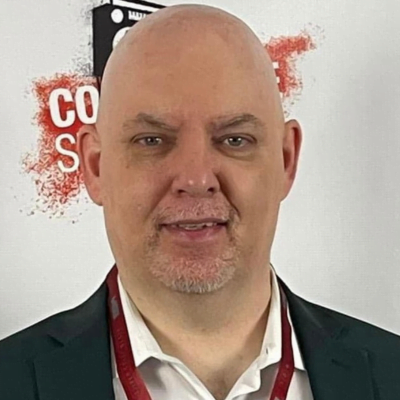
Jason Barrett is the President and Founder of Barrett Media since the company was created in September 2015. Prior to its arrival, JB served as a sports radio programmer, launching brands such as 95.7 The Game in San Francisco, and 101 ESPN in St. Louis. He also spent time programming SportsTalk 950 in Philadelphia, 590 The Fan KFNS in St. Louis, and ESPN 1340/1390 in Poughkeepsie, NY. Jason also worked on-air and behind the scenes in local radio at 101.5 WPDH, WTBQ 1110AM, and WPYX 106.5. He also spent two years on the national stage, producing radio shows for ESPN Radio in Bristol, CT. Among them included the Dan Patrick Show, and GameNight.
You can find JB on Twitter @SportsRadioPD. He’s also reachable by email at Jason@BarrettMedia.com.




